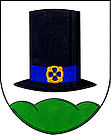Valašské Klobouky
| Valašské Klobouky | ||||
|---|---|---|---|---|
|
||||
| Basic data | ||||
| State : |
|
|||
| Region : | Zlínský kraj | |||
| District : | Zlín | |||
| Area : | 2694 ha | |||
| Geographic location : | 49 ° 8 ' N , 18 ° 1' E | |||
| Height: | 405 m nm | |||
| Residents : | 4,951 (Jan 1, 2019) | |||
| Postal code : | 766 17 | |||
| License plate : | Z | |||
| traffic | ||||
| Street: | Horní Lideč - Brumov-Bylnice | |||
| Railway connection: | Bylnice – Vsetín | |||
| structure | ||||
| Status: | city | |||
| Districts: | 4th | |||
| administration | ||||
| Mayor : | Dalibor Maniš (status: 2007) | |||
| Address: | Masarykovo náměstí 189 766 17 Valašské Klobouky |
|||
| Municipality number: | 585891 | |||
| Website : | www.valasskeklobouky.cz | |||
Valašské Klobouky (German Wallachian Klobouk , older also Klobuch ) is a town with 5039 inhabitants (as of Jan. 1, 2014) in the Zlínský kraj region ( Czech Republic ).
geography
The city is located in the Brumovka Valley in the northern part of the White Carpathians .
history
In the 14th century the place was granted numerous privileges. In 1356 it was named a town, was allowed to hold markets and was given its own jurisdiction . From the 16th century it was already referred to as a city. The position of the town was strengthened by the Emperor Sigismund , who wanted to strengthen his position in relation to the nearby Brumov Castle , which was occupied by the Hussites .
During the war with Hungary, numerous villages in the area were burned down. The lands then belonged to the Lords of Podmanitz ( Podmaničtí z Podmanic ). The municipality experienced its greatest boom at the end of the Middle Ages under the rule of the Lords of Lomnitz ( z Lomnice ). The city was Protestant until the early 17th century when it was re-Catholicized by the Jesuits .
During the Thirty Years War , the city was raided and robbed several times. In the 18th and 19th centuries, more and more craftsmen and, above all, weavers settled in the village, who, alongside agriculture, grew into the strongest economic branch. In the 20th century mechanical engineering and weapons construction followed.
After 1960 the city was assigned seven municipalities as part of the regional reform.
Personalities
- Josef Balejka (1917–2004), war hero
- Jaroslav Bařinka (1909–1980), director, radio play author
- Milena Fucimanová (* 1944), writer, poet, translator
- Franz Gessner (1879–1975), architect
- Hubert Gessner (1871–1943), architect
- Bedřich Havlíček (1922–1994), historian
- Zdeněk Matyáš (1945–2001), painter
- Jan Matzal (1881–1961), novelist
- Ladislav Mňačko (1919–1994), writer, dramaturge
- Jaroslav Pacák (1902–1984), painter, theoretician of fine arts
- Miloš Šperling (1925–1989), sculptor
Districts
- Lipina, an agricultural village with 246 inhabitants, first mentioned in 1407
- Mirošov, an agricultural village with 88 inhabitants, first mentioned in 1460
- Smolina, an agricultural village with 274 inhabitants, first mentioned in 1503


